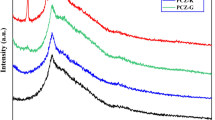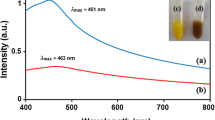Abstract
Zinc oxide nanoparticles (ZnO NPs) have anticancer, antidiabetic, antibacterial, and anti-inflammatory properties in the biotechnology field. Cafestol, which is the one of the diterpene in coffee, has antimicrobial and anticancer activities. This study aimed to synthesize the cafestol–chitosan–ZnO NP system to evaluate its antibacterial activity. ZnO NPs were produced by the chemical precipitation method. Optimization studies were performed to obtain the desired size of the ZnO NPs. The type of zinc salt [ZnCl2, Zn(SO4)], salt concentration (0.1; 0.2; 0.5 M), base type (NH3, NaOH), reaction time (6, 12, 18, 24 h), mixing speed (300, 400, 500 rpm), and calcination time (1, 2, 3 h) parameters in the method were investigated to yield the targeted size. The optimum experimental conditions required to synthesize in the 45–60 nm size range were determined as a 0.2 M Zn(SO4) salt type and concentration, NaOH base type, 18 h reaction time, at 400 rpm mixing speed and 2 h calcination time. After synthesizing the ZnO NPs coated with chitosan (CS), the cafestol was ligated to the CS–ZnO NP. It was proved by Fourier-transform infrared, differential scanning calorimeter/thermogravimetry analysis/diamond thermogravimetry analysis and scanning electron microscope analyses that cafestol–CS–ZnO NPs were successfully synthesized. The antibacterial effects of cafestol, CS, ZnO NPs, CS–ZnO NPs and cafestol–CS–ZnO NPs were evaluated on human pathogenic Gram-positive strains Staphylococcus aureus ATCC 25923 and Bacillus cereus ATCC 11778 and Gram-negative strains Pseudomonas aeruginosa PA01and Escherichia coli ATCC 25922. The ZnO NPs, CS–ZnO NP, and cafestol–CS–ZnO NP (varying between 20 and 1000 μg/mL) completely inhibited bacterial growth for S. aureus, B. cereus, and E. coli. The incorporation of CS and CS–cafestol improved the antibacterial activity of the ZnO NPs samples against P. aeruginosa PA01 with a 75–87.5% inhibition. The obtained data shows that CS–ZnO and cafestol–CS–ZnO NPs have great potential for biological and pharmaceutical applications.

















Similar content being viewed by others
References
AbdElhady MM (2012) Preparation and characterization of chitosan/zinc oxide nanoparticles for imparting antimicrobial and UV protection to cotton fabric. Int J Carbohydr Chem 2012:1–6
Ali SG, Ansari MA, Alzohairy MA, Alomary MN, Jalal M, AlYahya S, Khan HM (2020) Effect of biosynthesized ZnO nanoparticles on multi-drug resistant Pseudomonas aeruginosa. J Antibiot 9(5):260
Alwan RM, Kadhim QA, Sahan KM, Ali RA, Mahdi RJ, Kassim NA, Jassim AN (2015) Synthesis of Zinc Oxide nanoparticles via sol–gel route and their characterization. J Nanosci Nanotechnol 5(1):1–6
Bhadra P, Mitra MK, Das GC, Dey R, Mukherjee S (2011) Interaction of chitosan capped ZnO nanorods with Escherichia coli. Mater Sci Eng, C 31(5):929–937
Bharathi D, Ranjithkumar R, Chandarshekar B, Bhuvaneshwari V (2019) Preparation of chitosan coated zinc oxide nanocomposite for enhanced antibacterial and photocatalytic activity: as a bionanocomposite. Int J Biol Macromol 129:989–996
Diggle SP, Whiteley M (2020) Microbe Profile: Pseudomonas aeruginosa: opportunistic pathogen and lab rat. Microbiology 166(1):30–33
Dizaj SM, Lotfipour F, Jalali MB, Zarrintan MH, Adibkia K (2014) Antimicrobial activity of the metals and metal oxide nanoparticles. Mater Sci Eng, C 44:278–284
Dwivedi S, Wahab R, Khan F, Mishra KY, Musarrat J, Al-Khedhairy AA (2014) Reactive oxygen species mediated bacterial biofilm inhibition via zinc oxide nanoparticles and their statistical determination. PLoS ONE 9(11):e111289
El-Behery EI, El-Naseery NI, El-Ghazali HM, Elewa YHA, Mahdy EAA, El-Hady E, Konsowa MMH (2019) The efficacy of chronic zinc oxide nanoparticles using on testicular damage in the streptozotocin-induced diabetic rat model. Acta Histochem 121(1):84–93
Emami-Karvani Z, Chehrazi P (2011) Antibacterial activity of ZnO nanoparticle on gram-positive and gram-negative bacteria. Afr J Microbiol Res 5(12):1368–1373
Gordon T, Perlstein B, Houbara O, Felner I, Banin E, Margel S (2011) Synthesis and characterization of zinc/iron oxide composite nanoparticles and their antibacterial properties. Colloids Surf A Physicochem Eng Asp 374(1–3):1–8
Hassan HFH, Mansour AM, Abo-Youssef AMH, Elsadek BEM, Messiha BAS (2017) Zinc oxide nanoparticles as a novel anticancer approach; in vitro and in vivo evidence. Clin Exp Pharmacol Physiol 44(2):235–243
He J, Shao W, Zhang L, Deng C, Li C (2009) Crystallization behavior and UV-protection property of PET-ZnO nanocomposites prepared by In Situ polymerization. J Appl Polym Sci 114:1303–1311
Hopkins SP, Handa H (2019) Zinc-oxide nanoparticles act catalytically and synergistically with nitric oxide donors to enhance antimicrobial efficacy. J Biomed Mater Res A 107(7):1425–1433
Im H, Choi SY, Son S, Mitchell RJ (2017) Combined application of bacterial predation and violacein to kill polymicrobial pathogenic communities. Sci Rep 7:1–10
Jalal R, Goharshadi EK, Abareshi M, Moosavi M, Yousefi A, Nancarrow P (2010) ZnO nanofluids: green synthesis, characterization, and antibacterial activity. Mater Chem Phys 121(1–2):198–201
Janaki CA, Sailatha E, Gunasekaran S (2015) Synthesis, characteristics and antimicrobial activity of ZnO nanoparticles. Spectrochim Acta A 144:17–22
Javed R, Usman M, Tabassum S, Zia M (2016) Effect of capping agents: structural, optical and biological properties of ZnO nanoparticles. Appl Surf Sci 386:319–326
Jones N, Ray B, Ranjit KT, Manna AC (2008) Antibacterial activity of ZnO nanoparticles suspensions on a broad spectrum of microorganisms. FEMS Microbiol Lett 279(1):71–76
Kim CS, Nguyen HD, Ignacio RM, Kim JH, Cho HC, Maeng EH, Kim YR, Kim MK, Park BK, Kim SK (2014) Immunotoxicity of zinc oxide nanoparticles with different size and electrostatic charge. Int J Nanomed 9(2):195–205
Koutu V, Ojha P, Shastri L, Malik MM (2018) Study of the effect of temperature gradient on the thermal and electrical properties of ZnO nanoparticles. AIP conference proceedings 1953, pp 1–5
Kumar SS, Venkateswarlu P, Rao RV, Rao NG (2013) Synthesis, characterization and optical properties of zinc oxide nanoparticles. Int Nano Lett 3:1–6
Lee KJ, Jeong HG (2007) Protective effects of kahweol and cafestol against hydrogen peroxide-induced oxidative stress and DNA damage. Toxicol Lett 173(2):80–87
Lee DW, Power K, Boney R (2004) Physicochemical properties and blood compatibility of acylated chitosan nanoparticles. Carbohydr Polym 58(4):371–377
Ma D, Guan J, Normandin F, Denommee S, Enright G, Veres T, Simard B (2006) Multifunctional nano-architecture for biomedical applications. Chem Mater 18(7):1920–1927
Mohan CA, Renjanadevi B (2016) Preparation of zinc oxide nanoparticles and its characterization using scanning electron microscopy (SEM) and X-Ray diffraction (XRD). Proc Technol 24:761–766
Ogunsona E, Ojogbo E, Mekonnen T (2018) Advanced material applications of starch and its derivatives. Eur Polym J 108:570–581
Özbay E, Gülce H (2014) Çinko oksit nanopartikülleri sentezi ve karakterizasyonu. Selcuk Univ J Eng Sci Tech 2(4):1–5
Padmavathy N, Vijayaraghavan R (2008) Enhanced bioactivity of ZnO nanoparticles an antimicrobial study. Sci Technol Adv Mater 9(3):035004
Panchal P, Ogunsona E, Mekonnen T (2018) Trends in advanced functional material applications of nanocellulose. Processes 7(10):1–27
Rai M, Yadav A, Gade A (2009) Silver nanoparticles as a new generation of antimicrobials. Biotechnol Adv 27(1):76–83
Ren Y, Wang C, Xu J, Wang S (2019) Cafestol and Kahweol: a review on their bioactivities and pharmacological properties. Int J Mol Sci 20(17):4238
Russell AD (2003) Similarities and differences in the responses of microorganisms to biocides. J Antimicrob Chemother 52(5):750–763
Samuel E, Murphy L, Murphy CJ (2012) Applications of colloidal ınorganic nanoparticles: from medicine to energy. J Am Chem Soc 134(38):15607–15620
Sawai J (2003) Quantitative evaluation of antibacterial activities of metallic oxide powders (ZnO, MgO and CaO) by conductimetric assay. J Microbiol Meth 54(2):177–182
Sawant VJ, Bamane SR (2018) PEG-beta-cyclodextrin functionalized zinc oxide nanoparticles show cell imaging with high drug payload and sustained pH responsive delivery of curcumin into MCF-7 cells. J Drug Deliv Sci Tech 43:397–408
Seil JT, Webster TJ (2012) Antimicrobial applications of nanotechnology methods and literature. Int J Nanomed 7:2767–2781
Shoundhar A, Jayakrishna K (2019) Investigations on mechanical and morphological characterization of chitosan reinforced polymer nanocomposites. Mater Res Express 6(7):1–16
Sondi I, Salopak-Sondi B (2004) Silver nanoparticles as antimicrobial agent: a case study on E. coli as a model for Gram-negative bacteria. J Colloid Interf Sci 275(1):177–182
Souza VGL, Rodrigues C, Valente S, Pimenta C, Pires JRA, Alves MM, Santos CF, Coelhoso IM, Fernando AL (2020) Eco-friendly ZnO/Chitosan bionanocomposites films for packaging of fresh poultry meat. Coatings 10(2):1–20
Srivastava V, Gusain D, Sharma CY (2013) Synthesis, characterization and application of zinc oxide nanoparticles (n-ZnO). Ceram Int 39(8):9803–9808
Stoimenov PK, Klinger RL, Marchin GL, Klabunde KJ (2002) Metal oxide nanoparticles as bactericidal agents. Langmuir 18(17):6679–6686
Sunying Z, Ping Y, Sheng C, Zhulai L (2003) Studies on the catalytic degradation of chitosan by lipase. J Fujian Med Univ 36(3):302–305
Tani T, Mädler L, Pratsinis SE (2002) Homogeneous ZnO nanoparticles by flame spray pyrolysis. J Nanopart Res 4:337–343
Terrile EA, Marcheafave GG, Oliveira SG, Rakocevic M, Bruns ER, Scarminin SI (2016) Chemometric analysis of UV characteristic profile and infrared fingerprint variations of coffea Arabica green beans under different space management treatments. J Braz Chem Soc 27(7):1254–1263
Tseng YK, Chuang MH, Chen YC, Wu CH (2012) Synthesis of 1D, 2D and 3D ZnO polycrystalline nanostructures using the Sol-Gel method. Int J Nanotechnol 2012:1–8
Wahab R, Kim YS, Mishra A, Yun SI, Shin HS (2010) Formation of ZnO micro-flowers prepared via solution process and their antibacterial activity. Nanoscale Res Lett 5(10):1675–1681
WHO (2017) Antibacterial agents in clinical development: an analysis of the antibacterial clinical development pipeline, ıncluding tuberculosis geneva: world health organization. https://www.who.int/medicines/areas/rational_use/antibacterial_agents_clinical_development/en/
Xie Y, He Y, Irwin PL, Jin T, Shi X (2011) Antibacterial activity and mechanism of zinc oxide nanoparticles on Campylobacter jejuni. Appl Environ Microbiol 77(7):2325–2331
Xu HY, Wang H, Zhang YC, He WL, Zhu MK, Wang B, Yan H (2004) Hydrothermal synthesis of zinc oxide powders with controllable morphology. Ceram Int 30(1):93–97
Xu L, Guo Y, Liao Q, Zhang J, Xu D (2005) Morphological control of ZnO nanostructures by electrodeposition. J Phys Chem B 109(28):13519–13522
Yin X, Li Q, Wei H, Chen N, Wu S, Yuan Y, Liu B, Chen C, Bi H, Guo D (2019) Zinc oxide nanoparticles ameliorate collagen lattice contraction in human tenon fibroblasts. Arch Biochem Biophys 669:1–10
Zhang Z, Wanga B, Kang R, Zhang B, Guo D (2015) Changes in surface layer of silicon wafers from diamond scratching. CIRP Ann Manuf Technol 64(1):349–352
Zhang Z, Wang B, Zhou P, Kang R, Zhang B, Guo D (2016) A novel approach of chemical mechanical polishing for cadmium zinc telluride wafers. Sci Rep 6:26891
Zhang Z, Shia Z, Dua Y, Yu Z, Guo L, Guo D (2018) A novel approach of chemical mechanical polishing for a titanium alloy using an environment-friendly slurry. Appl Surf Sci 427(A):409–415
Zhang Z, Liao L, Wang X, Xie W, Guo D (2020) Development of a novel chemical mechanical polishing slurry and its polishing mechanisms on a nickel alloy. Appl Surf Sci 506:144670
Acknowledgements
We are grateful to Ege University Planning and Monitoring Coordination of Organizational Development and Directorate of Library and Documentation for their support in editing and proofreading service of this study.
Author information
Authors and Affiliations
Corresponding author
Ethics declarations
Conflict of interest
The authors declare no conflict of interest.
Additional information
Publisher's Note
Springer Nature remains neutral with regard to jurisdictional claims in published maps and institutional affiliations.
Rights and permissions
About this article
Cite this article
Ballıca, G., Çevikbaş, H., Ulusoy, S. et al. The synthesis of novel cafestol loaded zinc oxide nanoparticles and their characterization. Appl Nanosci 10, 4263–4272 (2020). https://doi.org/10.1007/s13204-020-01525-5
Received:
Accepted:
Published:
Issue Date:
DOI: https://doi.org/10.1007/s13204-020-01525-5




